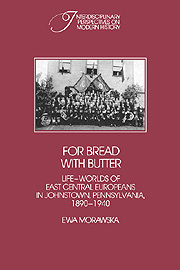Description
For Bread with Butter
The Life-Worlds of East Central Europeans in Johnstown, Pennsylvania, 1890–1940
Interdisciplinary Perspectives on Modern History Series
Author: Morawska Ewa
Tomlins offers here a critical examination of the impact of the National Labor Relations Act on American unions.
Language: English
Subject for For Bread with Butter:
Approximative price 158.58 €
Subject to availability at the publisher.
Add to cart
For Bread with Butter
Publication date: 01-1986
Support: Print on demand
Publication date: 01-1986
Support: Print on demand
Approximative price 41.42 €
Subject to availability at the publisher.
Add to cart
'for bread with butter': the life-worlds of east central europeans in johnstown, pennsylvania, 18901940
Publication date: 01-2004
448 p. · 15.2x22.9 cm · Paperback
Publication date: 01-2004
448 p. · 15.2x22.9 cm · Paperback
Description
/li>Contents
/li>
Fifty years ago, enactment of the Wagner National Labor Relations Act gave American organized labour what it has regarded ever since as one of its greatest assets: a legislative guarantee of the right of workers to organize and bargain collectively. Yet although the Wagner Act's guarantees remain substantially unaltered, organized labour in America today is in deep decline. Addressing this apparent paradox, Christopher Tomlins offers here a critical examination of the impact of the National Labor Relations Act on American unions. By studying the intentions and goals of policy makers in the context of the development of labour law from the late nineteenth century, and by looking carefully at the course of labour history since the act's passage, Dr Tomlins shows how public policy has been shaped to confine labour's role in the American economy, and that many of the unions' problems stem from the laws which purport to protect them.
List of ilustrations; List of tables; Acknowledgements; Introduction; 1. Backgrounds; 2. To America; 3. Johnstown and the immigrant communities before World War 1; 4. The beginnings: strategies of adaptation; 5. Johnstown and the immigrant communities between the wars; 6. For bread with butter; 7. Internal social stratification in the immigrant communities; 8. The second generation; Conclusion; Notes; Appendix; Index.
© 2024 LAVOISIER S.A.S.



